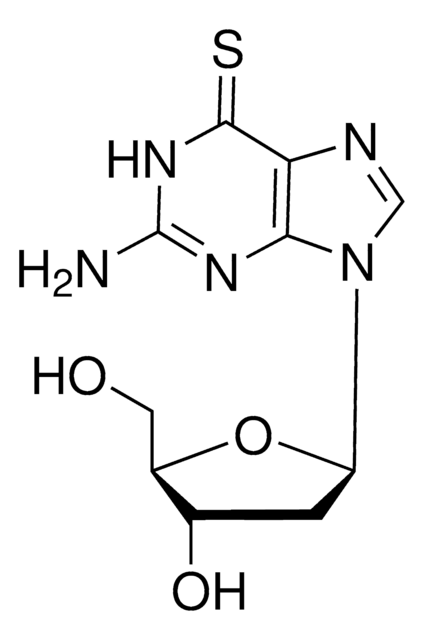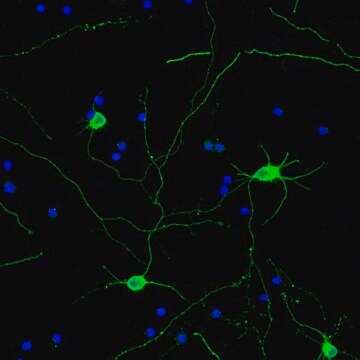推薦產品
生物源
human
重組細胞
expressed in E. coli
化驗
≥98% (HPLC)
≥98% (SDS-PAGE)
形狀
lyophilized
效力
1.0-10.0 mg per mL
分子量
13.2 kDa
包裝
pkg of 20 μg
技術
cell culture | mammalian: suitable
雜質
<0.1 EU/μg endotoxin, tested
顏色
white
UniProt登錄號
運輸包裝
wet ice
儲存溫度
−20°C
基因資訊
human ... TFF3(7033)
一般說明
Researcharea: Cell Signaling
The trefoil factor peptides (TFF1, TFF2, and TFF3) are secreted in the gastrointestinal tract. They are secreted peptides which are protease-resistant. TFF-3 is expressed by goblet cells and in the uterus, and has also been shown to be expressed in certain cancers, including colorectal, hepatocellular, and in biliary tumors. Recombinant human TFF3 is a homodimeric protein consisting of two 59 amino acid chains, which includes a 40-amino acid trefoil motif containing three conserved intramolecular disulfide bonds.
The trefoil factor peptides (TFF1, TFF2, and TFF3) are secreted in the gastrointestinal tract. They are secreted peptides which are protease-resistant. TFF-3 is expressed by goblet cells and in the uterus, and has also been shown to be expressed in certain cancers, including colorectal, hepatocellular, and in biliary tumors. Recombinant human TFF3 is a homodimeric protein consisting of two 59 amino acid chains, which includes a 40-amino acid trefoil motif containing three conserved intramolecular disulfide bonds.
應用
TFF3 human has been used in surface plasmon resonance(SPR) binding analysis to study the molecular interactions between TFF3 and the aminonitrile compound and its effect on inhibition of TFF3-dependent cancer cell survival.
生化/生理作用
The trefoil factor peptides (TFF1, TFF2, and TFF3) play an important role in intestinal mucosal maintenance, defense, and repair. TFF3 also promotes airway epithelial cell migration and differentiation. TFF3 may be useful as a molecular marker for certain types of cancer. TFF3 interacts with the CD147 receptor to promote migration, invasion, and proliferation in colorectal cancer (CRC), Indicating its involvement in cancer progression. TFF3 stimulates the replication of pancreatic islet β-cells in humans and rodents, leading to increased proliferation while preserving their functionality. The effects of TFF3 on β-cell proliferation have been associated with the activation of the protein kinase B(Akt) and epidermal growth factor receptor (EGFR) signaling pathways.
序列
EEYVGLSANQ CAVPAKDRVD CGYPHVTPKE CNNRGCCFDS RIPGVPWCFK PLQEAECTF
外觀
Lyophilized with no additives.
重構
Centrifuge the vial prior to opening. Reconstitute in water to a concentration of 0.1-1.0 mg/ml. Do not vortex. This solution can be stored at 2-8°C for up to 1 week. For extended storage, it is recommended to further dilute in a buffer containing a carrier protein (example 0.1% BSA) and store in working aliquots at -20°C to -80°C.
儲存類別代碼
11 - Combustible Solids
水污染物質分類(WGK)
WGK 3
閃點(°F)
Not applicable
閃點(°C)
Not applicable
Steen Seier Poulsen et al.
Regulatory peptides, 126(3), 163-171 (2005-01-25)
Peptides of the trefoil factor family (TFF1, TFF2 and TFF3) are cosecreted with mucus from mucus-producing cells in most organ systems and are believed to interact with mucus to form high-viscosity stable gel complexes. In the gastrointestinal tract, they sustain
P-O Lafontaine et al.
Journal francais d'ophtalmologie, 26(10), 1007-1014 (2003-12-24)
Trefoil factor family (TFF) peptides (formerly P-domain peptides; trefoil factor) are small (7-12 kDa) protease-resistant secreted peptides designated pS2 (or TFF1), SP (TFF2) and ITF (TFF3). Human conjunctival goblet cells (GCs) are known to synthesize TFF, but TFF expression by
Shu Q Liu et al.
PloS one, 8(10), e77732-e77732 (2013-11-10)
Cerebral ischemia, while causing neuronal injury, can activate innate neuroprotective mechanisms, minimizing neuronal death. In this report, we demonstrate that experimental cerebral ischemia/reperfusion injury in the mouse causes upregulation of the secretory protein trefoil factor 3 (TFF3) in the hepatocyte
Ting-yi Du et al.
PloS one, 8(11), e80271-e80271 (2013-11-28)
Trefoil factor 3 (TFF3) is a small peptide that plays an important role in mucosal protection, cell proliferation, and cell migration. The aberrant expression of TFF3 is correlated with gastrointestinal inflammation, solid tumors, and other clinical diseases. The objective of
Dale Porter et al.
Molecular cancer research : MCR, 1(5), 362-375 (2003-03-26)
Gene expression patterns in ductal carcinoma in situ (DCIS), and in invasive, and metastatic breast tumors were determined using serial analysis of gene expression (SAGE). We used mRNA in situ hybridization to examine gene expression at the cellular level and
我們的科學家團隊在所有研究領域都有豐富的經驗,包括生命科學、材料科學、化學合成、色譜、分析等.
聯絡技術服務








